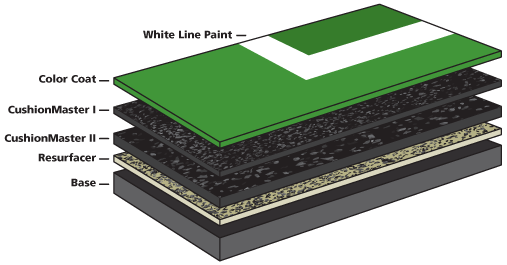Budget-friendly Pickleball Court Construction for Houses and Communities
Budget-friendly Pickleball Court Construction for Houses and Communities
Blog Article
Sustainable Practices in Pickleball Court Building And Construction You Should Know
As the popularity of pickleball continues to climb, so too does the requirement for lasting practices in court construction. The effect of these techniques extends far beyond the court itself.
Picking Eco-Friendly Products
Choosing green materials is an essential action in the building of lasting pickleball courts. The choice of sustainable products not just minimizes environmental influence however also boosts the longevity and efficiency of the court. Trick products include reused rubber for the surface, which offers exceptional durability and shock absorption while diverting waste from landfills.
In addition, using in your area sourced products decreases transport emissions and supports regional economies. Pickleball court construction. For instance, utilizing native hardwoods for fence and seats can provide a lasting aesthetic while ensuring strength against the components.
Incorporating permeable materials for court foundations can further add to sustainability by permitting all-natural water drain and lowering overflow. These choices not only shield regional ecosystems yet additionally advertise healthier play atmospheres.
Reliable Water Drainage Solutions
While the selection of environment-friendly products is vital, carrying out efficient drain remedies is just as crucial for keeping lasting pickleball courts. Correct drainage not only secures the court surface area from water damage but also minimizes disintegration and runoff, advertising ecological honesty.
Reliable water drainage systems can consist of permeable paving, which permits water to penetrate the ground instead of merging externally. This reduces the probability of standing water, which can result in mold and mildew and other upkeep concerns. Additionally, incorporating tactically positioned drainage channels and swales can direct excess water far from the court area, making sure a completely dry having fun surface and preventing dirt erosion.
Utilizing indigenous greenery in the landscape design around the courts can better boost drain by absorbing excess water and reducing runoff. These plants need less irrigation and advertise biodiversity, aligning with sustainable methods.
In addition, it is important to consistently maintain the drain system to guarantee its long-term efficiency. This includes cleaning particles and tracking for clogs. By focusing on efficient drainage remedies, pickleball court erectors can significantly contribute to the sustainability and durability of the center, eventually benefiting both players and the atmosphere.
Energy-Efficient Lights Options
As the need for pickleball continues to expand, integrating energy-efficient lighting choices into court layout has actually come to be increasingly essential for sustainability. Conventional illumination systems commonly take in extreme energy, contributing to greater operational prices and ecological effect. As a result, embracing contemporary, energy-efficient innovations is vital for both new buildings and remodellings.
LED (Light Emitting Diode) lights sticks out as a top choice because of its longevity and power savings (Pickleball court construction). Contrasted to conventional illumination, LEDs use about 75% less power and can last up to 25 times longer, significantly minimizing maintenance expenses. In addition, the directional nature of LED illumination decreases light contamination, ensuring that illumination is concentrated on the court instead than surrounding areas.

Sustainable Surface Alternatives
Exploring lasting surface area options for pickleball courts has gotten grip amongst players and home builders alike. The focus on green products not only lines up with the growing environmental awareness but also enhances the efficiency and toughness of the courts.
One preferred choice is making use of recycled rubber, which can be look what i found sourced from utilized tires. This material offers excellent shock absorption, reducing the threat of injuries for gamers while promoting sustainability. Additionally, modular tiles made from recycled plastics offer an additional practical option. These floor tiles are very easy to change and install, and their convenience enables numerous court arrangements.
Natural turf courts are likewise becoming a sustainable choice, promoting biodiversity and minimizing the warmth island result. They need regular upkeep and water, which might not align with all sustainability goals.

Water Preservation Techniques

An additional efficient strategy includes the installment of rainwater harvesting systems. These systems accumulate and store rainwater for usage in maintaining court surface areas and landscape design. This method not just preserves drinkable water yet also minimizes dependence on metropolitan sources.
Additionally, using drought-resistant landscape design around the courts is important. Native plants need less water and are much better adapted to regional climate problems, thus reducing general water consumption. Furthermore, using reliable watering systems, such as drip watering, guarantees that water is provided straight to plant origins, decreasing evaporation and waste.
Final Thought
Integrating lasting methods in pickleball court building substantially adds to ecological preservation and resource effectiveness. Using environment-friendly products, executing efficient drainage solutions, and taking on energy-efficient lights choices can significantly decrease ecological influence. In addition, checking out sustainable surface area options and employing water preservation methods enhance the total sustainability like this of these leisure centers - Pickleball court construction. By focusing on these practices, the building of pickleball courts can align with more comprehensive environmental goals while advertising longevity and performance within communities.
As the appeal of pickleball proceeds to climb, so too does the requirement for lasting techniques in court construction.Choosing environmentally friendly materials is a vital action in the building of sustainable pickleball courts. By prioritizing energy-efficient lights alternatives, pickleball court erectors can add to a much more sustainable future while satisfying the requirements of stakeholders and players alike.Incorporating lasting surface alternatives not only boosts the efficiency of pickleball courts yet likewise paves the way for applying reliable water preservation methods.Incorporating lasting practices in pickleball court building and construction considerably contributes to webpage ecological preservation and source performance.
Report this page